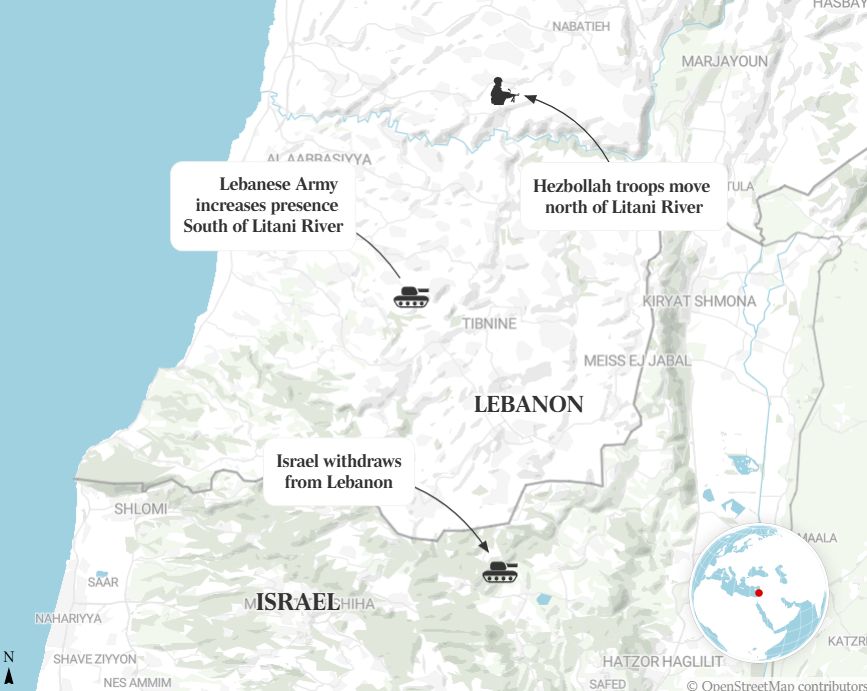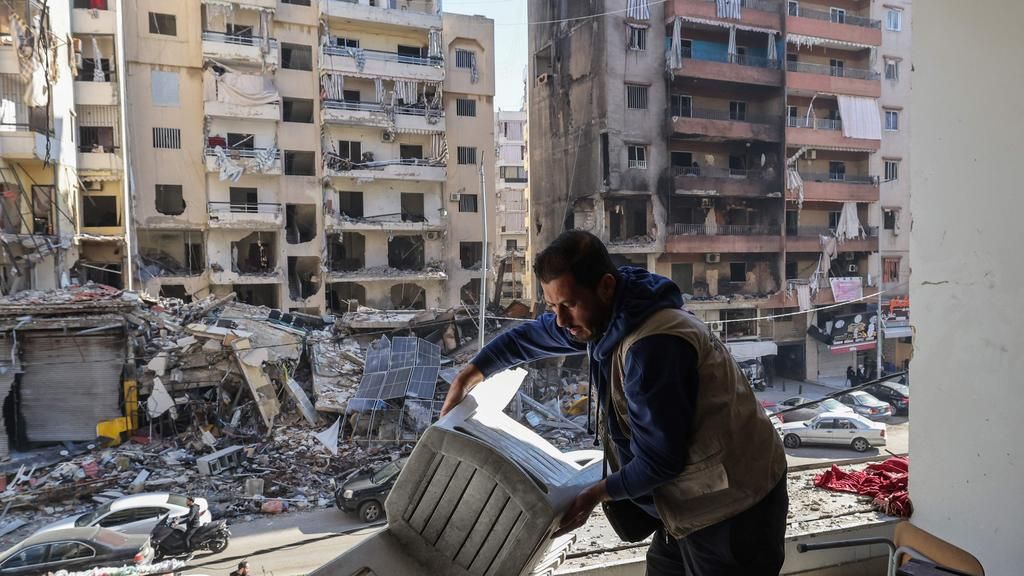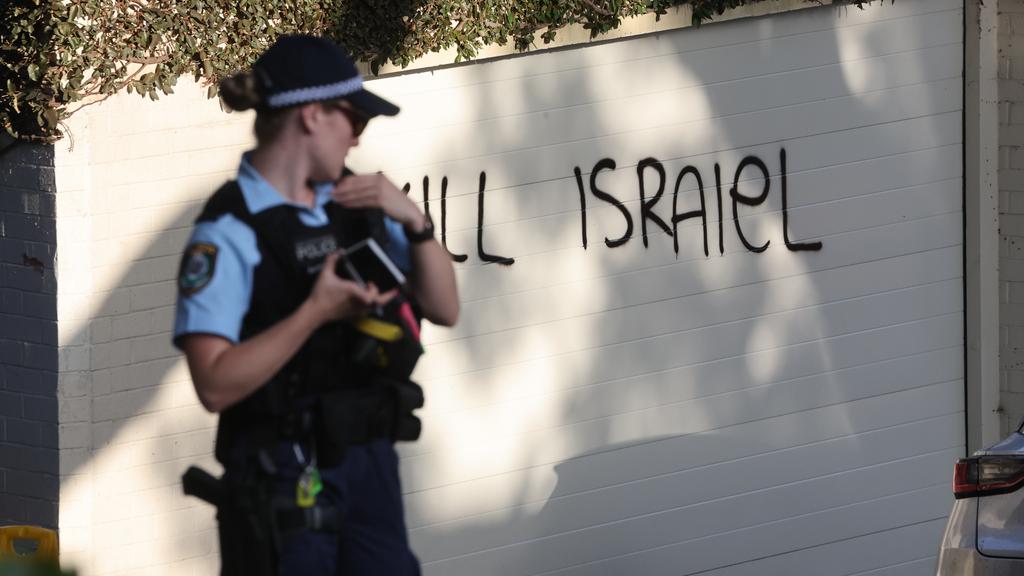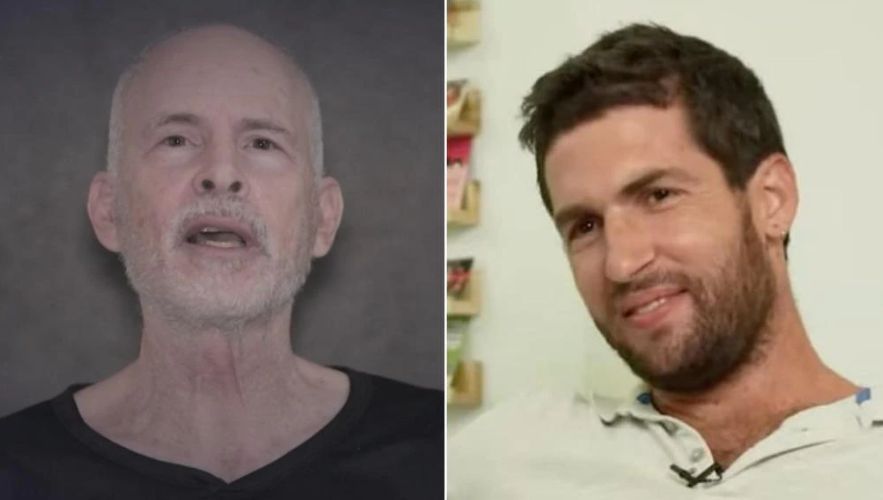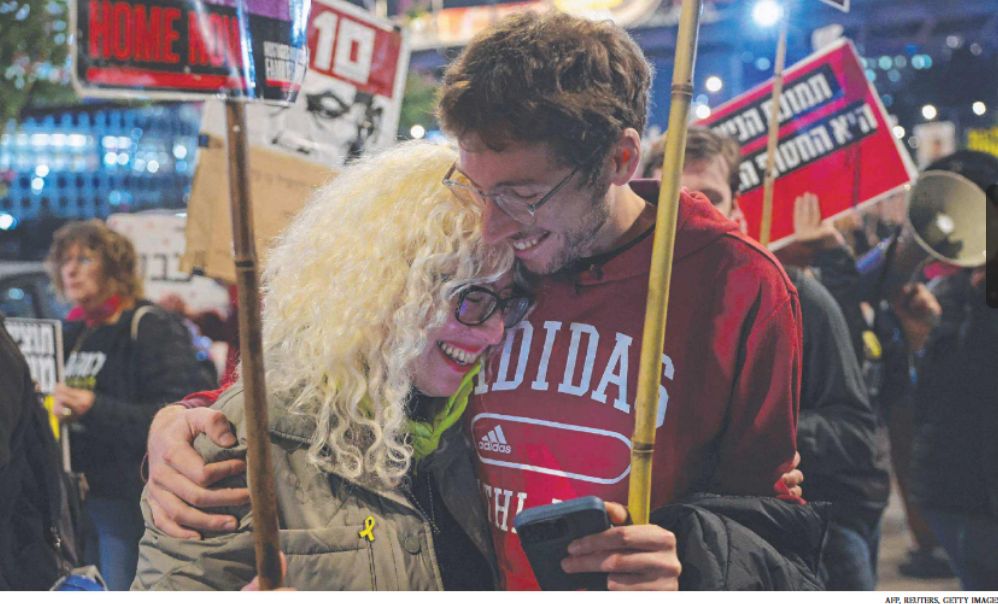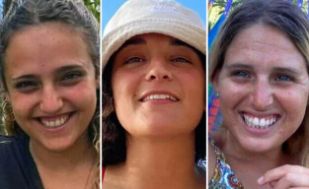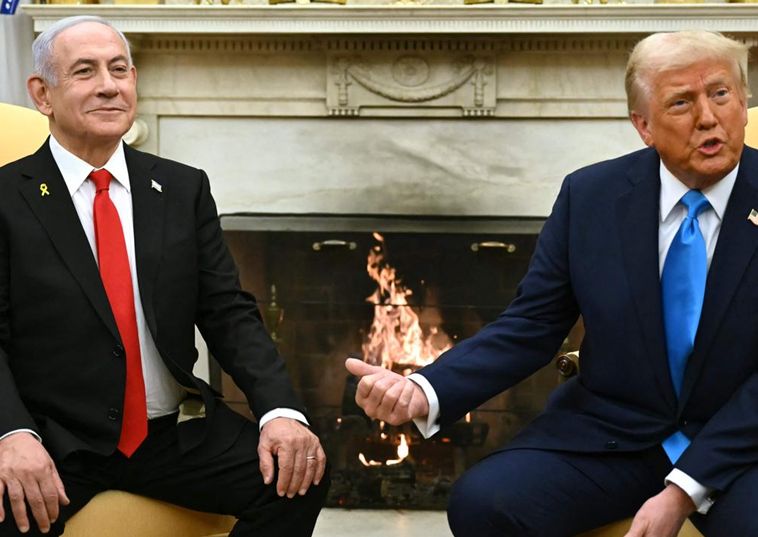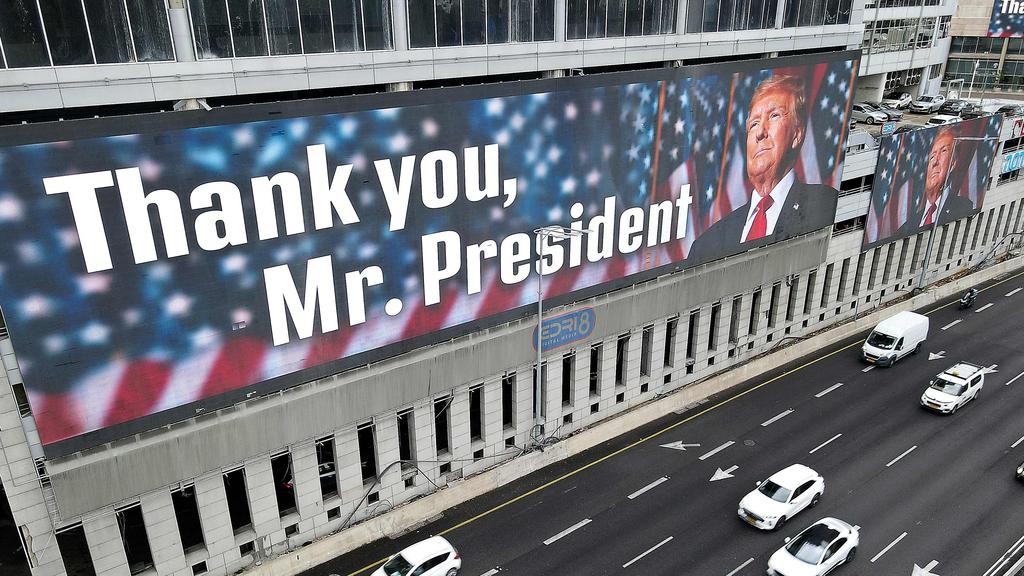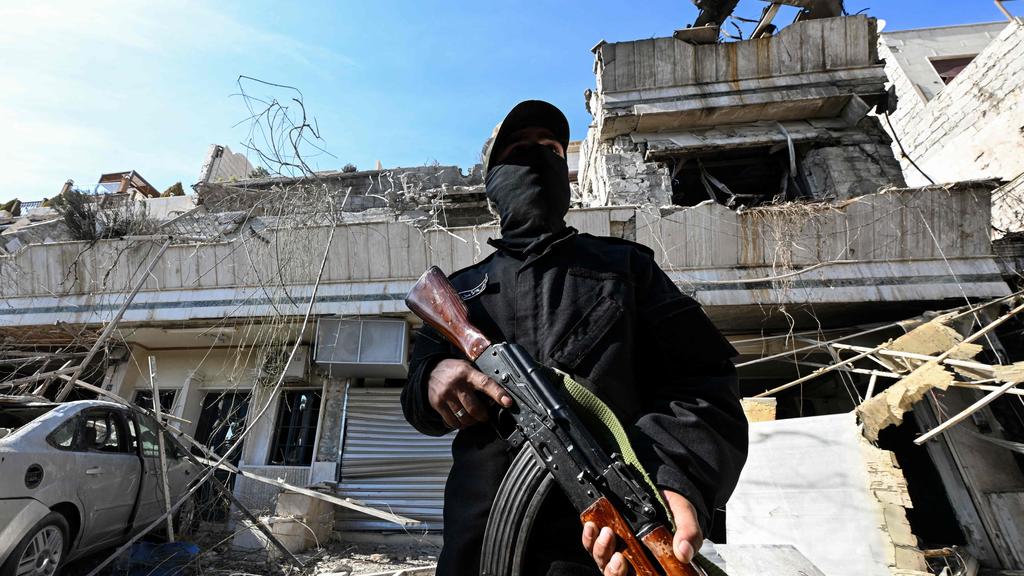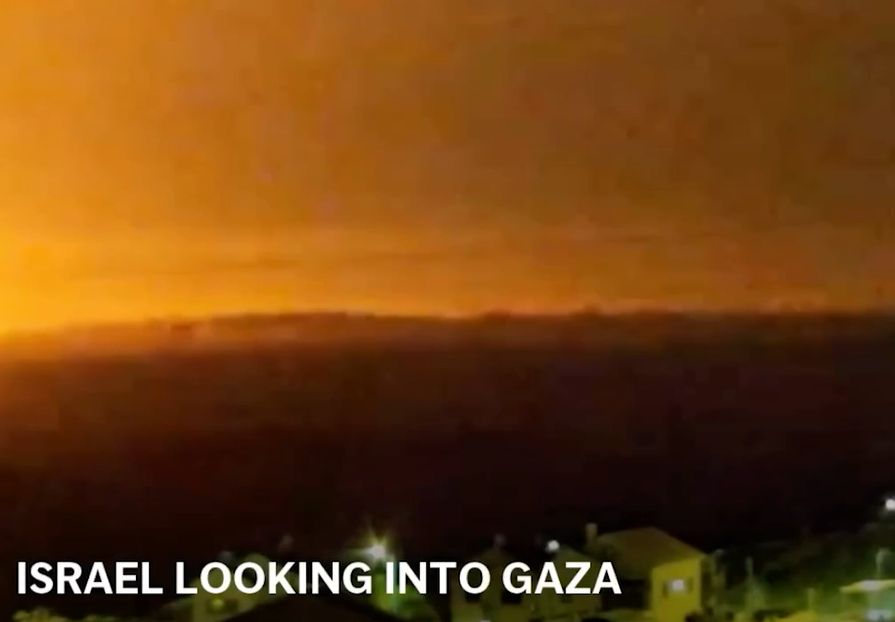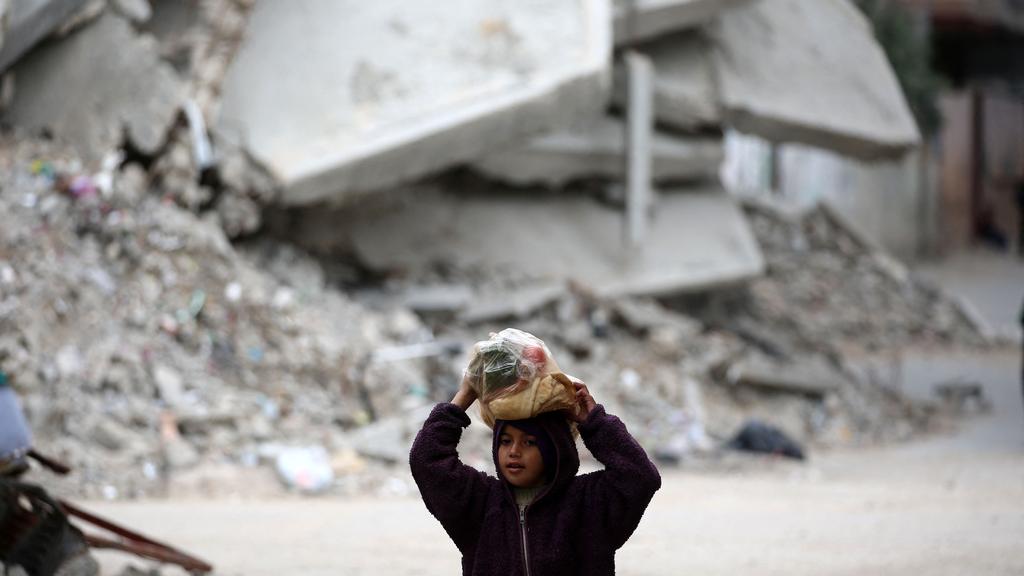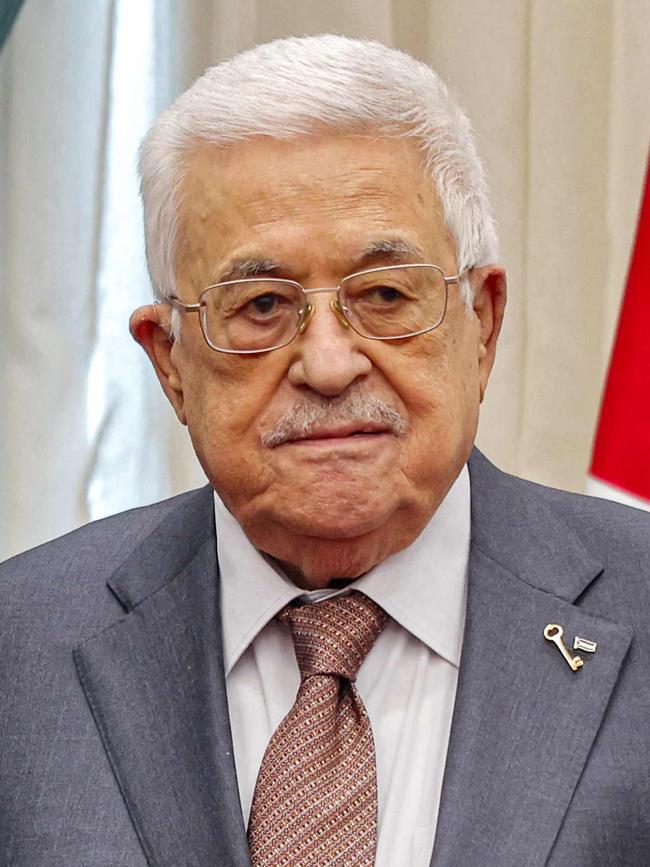Click here for prior news from June 15 2024
Click here to look at earlier maps (and events) over 4000 years of history for "Israel - Deep inside the plucky country".
October 2023
Israeli Prime Minister Benjamin Netanyahu said his country was at war with Hamas after the militant group’s forces poured across the border from Gaza on Saturday October 7, killing over 1,000 residents and capturing over 200 hostages.
News since November 27 2024
|
The Australian
Jacquelin Magnay and Noah Yim
Wednesday November 27 2024
A ceasefire deal between Israel and Lebanon has been accepted. US President Joe Biden has confirmed that Israel and Hezbollah have agreed a 60-day ceasefire, saying the truce heralds a “new start” for Lebanon.
Speaking after the Israeli cabinet voted the deal through 10-1, Mr Biden said: “This is designed to be a permanent cessation of hostilities,” Mr Biden said. He said Hezbollah – and what is left of the terrorist organisation – would “not be allowed to threaten the security of Israel again”.
The ceasefire agreement – overseen by the US and France – would see Israel withdraw troops over the next 60 days. Mr Biden said Israel “retains the right to self-defence” if Hezbollah “or anyone else” breaks the agreement. “This deal supports Lebanon’s sovereignty,” Mr Biden said. “So it heralds a new start for Lebanon – a country that I’ve seen most of over the years, a country with a rich history and culture. If fully implemented, this deal can put Lebanon on a path toward a future that’s worthy of its significant past.”
In a joint statement, Mr Biden and French President Emmanuel Macron said their two countries would ensure the ceasefire, to take effect at 4am local time (1pm AEDT) was “fully implemented.” They added that it would secure Israel “from threat of Hezbollah”. Israeli Prime Minister Benjamin Netanyahu said on Tuesday he was ready to implement a ceasefire deal with Lebanon and would respond forcefully to any violation by Hezbollah, declaring Israel would retain "complete military freedom of action."
Mr Biden repeated a call for a ceasefire in Gaza and for the remaining hostages to be released. “Just as Lebanese people deserve a future of security and prosperity, so do the people of Gaza. They too deserve an end to the fighting and displacement. People of Gaza have been through hell. Their world’s absolutely shattered. Far too many civilians in Gaza have suffered far too much. And Hamas has refused for months and months to negotiate a good faith ceasefire and a hostage deal. So now Hamas has a choice to make. Their only way out is to release the hostages including American citizens which they hold. In the process – bring an end to the fighting which would make possible a surge of humanitarian relief. Over the coming days, the US will make another push with Turkey, Egypt, Qatar, Israel and others to achieve a ceasefire in Gaza, for the hostages’ release, and the end of the war without Hamas in power.”
Mr Netanyahu thanked Mr Biden for US “involvement” in the Washington-led truce. Lebanon’s Prime Minister Najib Mikati welcomed the ceasefire, describing it as a crucial step toward stability, the return of displaced people to their homes and regional calm.
Earlier, Mr Netanyahu insisted the agreement allowed Israel “full liberty” to attack again if Hezbollah launched missiles, expanded its tunnel network or prepared for any aggression in violation of the ceasefire. “The duration of the ceasefire depends on what happens in Lebanon,” Mr Netanyahu said. “If Hezbollah violates it, we will attack. I hear the claim that we cannot renew the war. I remind you – this is precisely what I was told during the ceasefire in Gaza, and we returned to fight, and in a big way.”
As the Israeli Defence Forces pounded Hezbollah strongholds in Beirut, he stressed that Israel had set Hezbollah back decades, with the terror group now not enjoying the same capabilities, leadership or command structure anymore. “Hezbollah is no longer the same. We set them back decades,” he said. “We have destroyed many missiles and rockets, we have killed many terrorists.”
Mr Netanyahu said there were three reasons this was the right time for Israel to engage in a ceasefire with Hezbollah, with the priority to focus on removing the nuclear threat posed by Iran. “The first is to focus on the Iranian threat, enough said. The second is to refresh our forces and rearm our troops. There have been big delays in the supply of arms and this delay is about to stop soon,” he said. “We will arm ourselves with sophisticated arms to protect our troops and give us greater force to complete our missions. The third is to isolate Hamas. Hamas was counting on Hezbollah and once Hezbollah is eliminated, Hamas is left alone. Our pressure on Hamas will grow stronger and help in the sacred mission to bring back our hostages.”
The deal is for both sides to cease attacks for 60 days and for Hezbollah to pull back its troops north of the Litani river, which is about 30km from the Israeli border. The Lebanese government is to send 5000 of its own forces into this zone. The Israeli military will also withdraw its troops from Lebanese territory over the coming weeks.
Much of the deal is similar to a UN Security Council Resolution 1701 agreed back in 2006 to end conflict between Israel and Hezbollah, but which was often breached. The pact allows for further negotiations and a longer peace deal to be worked out over the next 60 days, leading to what is expected to be the end of the 14 month conflict which has caused thousands of deaths and displaced hundreds of thousands of people.
US Secretary of State Antony Blinken said the truce would help secure an end to the war in Gaza. “One of the things that Hamas has sought from day one is to get others in on the fight, to create multiple fronts … and as long as it thought that was possible, that’s one of the reasons it has held back from doing what is necessary to end the conflict,” Mr Blinken told reporters at the G7 in Italy. “If it sees that the cavalry is not on the way, that may incentivise it to do what it needs to do to end this conflict.”
On Tuesday, ahead of the agreement being signed off by the Israeli security cabinet, Israel launched a massive strike on southern Beirut suburbs, saying they were targeting Hezbollah’s naval missile unite and command headquarters.
The Israel army said 30 Hezbollah sites had been targeted in the past week and criticised the Iranian proxy group of operating from dense civilian areas to use the local population as human shields. The Tuesday strikes included 13 terror targets in the Dahieh area, taking out a Hezbollah aerial defence unit centre, an intelligence centre, command centre and weapons storage facilities. Seven other targets were components of Hezbollah’s financial system.
Footage shows in these final hours before the ceasefire Hezbollah had also fired a barrage of rockets into northern Israel.
An Israeli intelligence officer told NBC News that the ceasefire deal was intensely debated. “The strongest voices against this deal come from the leaders of the Israeli towns and villages along the north”, the official said. “All the leaders there are speaking with a very clear voice, in one voice, all of them say it is a terrible deal. That’s not what we expected. We are not going to urge our people to return to these dangerous places.”
British military analyst and former paratrooper Andrew Fox said the war has seen 60,000 Israelis displaced, over 17,500 rockets and drones launched at Israel, over 13,000 Hezbollah targets struck by Israel, over 2,100 Hezbollah operatives killed and over 14,500 wounded, with over 80 per cent of Hezbollah’s 130,000-150,000 missiles and rocket stores destroyed. He added: “The Israel Defence Force have cleared along the immediate border with Lebanon to destroy Hezbollah fighting locations and terror tunnels, which were found stocked with uniforms and weaponry to launch 7 October-style terror attacks into Israel itself.”
A five-country committee, chaired by the US is to ensure compliance with the ceasefire.
|
AFP
Wednesday December 4 2024
Nine people were killed in Israeli strikes on villages in southern Lebanon on Monday, after Israel said it was taking aim at dozens of Hezbollah targets in retaliation for an attack claimed by the militant group amid a fragile ceasefire. Israel and Hezbollah faced accusations of breaching the truce, which took effect last Wednesday to end a war that has killed thousands of people in Lebanon and sparked mass displacements on both sides of the border.
The Israeli military said it “struck Hezbollah terrorists, dozens of launchers, and terrorist infrastructure throughout Lebanon”. “Israel demands that the relevant parties in Lebanon fulfil their responsibilities and prevent Hezbollah’s hostile activity,” the statement said. Earlier, Hezbollah said it had launched an attack targeting an Israeli position in a disputed part of the border area between Israel and Lebanon.
Israel’s military said Hezbollah had launched two projectiles towards one of its posts in the area of Har Dov, Israel’s term for the disputed Shebaa Farms. Israeli Prime Minister Benjamin Netanyahu accused Hezbollah of a “serious violation” and vowed to “respond forcefully”. “We are determined to uphold the ceasefire and respond to any violation by Hezbollah, no matter how minor or serious,” he said. Israeli Defence Minister Israel Katz also vowed a “harsh response”. Shortly afterwards, the Israeli military said it was striking targets in Lebanon.
Lebanon’s official National News Agency reported strikes on areas of south Lebanon, where Hezbollah has long held sway, that are located around 20km from the border with Israel. Israel has carried out a near-daily series of strikes in southern Lebanon since the ceasefire was put in place, and earlier on Monday Beirut’s powerful parliament speaker Nabih Berri accused it of violating the truce. “The aggressive actions carried out by Israeli occupation forces... represent a flagrant violation of the terms of the ceasefire agreement,” said Mr Berri, who helped mediate the truce on behalf of ally Hezbollah.
Under the ceasefire deal, Hezbollah must withdraw its fighters from areas south of the Litani river, and dismantle its military infrastructure in the south. As part of the agreement, the Lebanese army and UN peacekeepers will deploy in southern Lebanon as the Israeli army withdraws over a period of 60 days. A committee involving France, UN peacekeepers, Israel, Lebanon and chaired by the US is tasked with maintaining communication between the various parties and ensuring violations are identified and dealt with to avoid any escalation.
|
The Australian front page
Cameron Stewart
Thursday December 12 2024
Anthony Albanese, it seems, finally gets it. His emotional and powerful press conference at Sydney’s Jewish Museum on Wednesday could, and should, have been given many, many months ago, long before the ugly spectre of anti-Semitism took root and spread its poison across this country. It took a car set alight in Sydney in an anti-Semitic attack for the second time in weeks and terrorist firebombing of a beloved synagogue in Melbourne’s Jewish heartland to shake an emotional Prime Minister into giving the sort of response that the country’s Jewish community and many non-Jewish Australian had been pleading for since Jews were targeted at the Opera House on October 9 last year.
By any measure, we are living through an ugly moment. We are seeing a scourge of anti-Semitism in this country on a scale that is unprecedented and is now creating global headlines.
So what has gone wrong until now? At one level, the answer is simple. Before the Prime Minister’s strong but belated response on Wednesday, the truth was that the fish had rotted from the head. This includes, but is not limited to, Albanese and Penny Wong who, through a mixture of naivety, weakness and expediency in failing to recognise and act on the problem early on, helped to set the permissive tone for what has followed. And now, it seems, the horse has bolted.
This was not their intention, but it is a reality and it amounts to a failure of political leadership.
When Wong’s increasingly hostile policies towards Israel see her criticising it on a near-daily basis, including by equating it this week with the dictatorships of Russia and China, it emboldens those misfits tempted by hate crimes.
No one is pretending that Albanese and Wong are not horrified by anti-Semitism, as all decent Australians are, and they are entirely within their rights politically to criticise Israel over its conduct in the Gaza war. But there are real-life consequences in Australia to the government’s policy backflip over Israel that should have been grappled with much earlier, before synagogues were burning. Language matters, actions matter, and until Wednesday, these have been too equivocal for too long.
As former Israeli foreign minister Tzipi Livni, who has observed anti-Semitism all her life, told me this week, societies that lacked strong political leadership to stamp out anti-Semitism early are doomed to have it rear its ugly head later.
Yet those with partisan political axes to grind who choose only to blame the federal government are ignoring the broader failures of leadership that have also led Australia to this moment.
In Victoria, where almost half of the 905 national instances of anti-Semitism took place in the past year, the Victorian state Labor government of Jacinta Allan has been all but missing in action. Allan did nothing as school kids skipped school to call for the eradication of Israel and has done nothing to act on anti-Semitic chants or the carrying of anti-Semitic signs at the weekly protests through the middle of Melbourne. It has largely taken a “nothing to see here” approach to the problem.
On campuses, vice-chancellors could not muster the courage to call out and take action against the racist elements of the anti-Israel encampments until the damage had been done and Jewish students all but chased from campus.
Police chiefs have also given the appearance of being paralysed by the conflict, instructing their officers to watch rather than swoop to stamp on anti-Semitism whenever it appears at rallies and in protests that have even been allowed to take place outside synagogues.
Local councils around the country have been little short of disgraceful, spending endless hours debating meaningless resolutions on Israel, many of which have been anti-Semitic rather than political, rather than concentrating on collecting the bins.
There have been some honourable exceptions to these failures of leadership. Ever since the disgraceful protest outside the Opera House on October 9 last year, NSW Premier Chris Minns has been far more proactive than either the federal government or his Victorian counterpart in condemning and taking action against anti-Semitism.
Albanese is now moving to take the issue as seriously as it should have been taken many months ago, by setting up an Australian Federal Police special operation for anti-Semitism.
But anti-Semitism in Australia has been festering and growing since October 7 last year. It should never have taken so long for this taskforce to emerge. And now the anti-Semitism genie is fully out of the bottle, with copycat crimes being committed. We’ve seen the danger of copycat hate crimes in Australia before. The deadly spate of Islamic State-inspired attacks here from 2014 to 2018 were carried out mostly by youths who bore hate in their hearts. Thankfully no one has yet been killed by acts of anti-Semitism, and the government is finally, belatedly, taking strong steps to tackle it. But it should never have got to this.
This fish should never have rotted at all, much less from the head.
Copycat crimes and anti-social criminals have been around for years, for those who watched "Once upon a time in Hollywood" with Brad Pitt, Leonardo DiCaprio and Margot Robbie, click here for a more accurate timeline involving Charles Manson (1935-2017). Along with Tex Watson, who, though still locked up in jail since those events 55 years ago in July-August 1969, has become a Christian minister. Irony everywhere. Who can tell? 
|
The Australian
Joe Kelly, Jacquelin Magnay, and Agencies
Thursday January 16 2025
Two American hostages are expected to be released in the first phase of the peace deal between Israel and Hamas, as the ceasefire begins on Sunday at 9.15pm (AEDT). The agreement for a ceasefire and hostage return was confirmed earlier on Thursday (AEDT), with Qatar confirming the truce would begin on Sunday.
Sagui Dekel-Chen, 36, released Feb 15 and Keith Siegel, who is in his 60s, released Feb 1 will be among the first tranche of freed hostages, which will see the release of women, children, elderly and wounded hostages, CNN, NBC and Reuters report. Mr Siegel’s wife, Aviva, was among those released in the 2023 ceasefire agreement. Mr Dekel-Chen was shot during the October 7 massacre, which qualified him for release under the wounded category, a US official told NBC.
Earlier this week, Arab media reported that American hostages were being moved to safe places ahead of the expected truce.
US President Joe Biden this morning confirmed the “full and complete” ceasefire in the first part of the peace accord, and said he had acted as “one team” with incoming leader Donald Trump.
Speaking at the White House just days before he leaves office, a visibly relieved Mr Biden said the negotiations to halt the Gaza conflict had been some of the “toughest” of his career. “I’m deeply satisfied this day has come, finally come,” Mr Biden said in a televised statement. A number of Americans would be among the hostages who would be released by Palestinian militants in Gaza, he added.
The first phase of the deal would last six weeks and include a “full and complete ceasefire, withdrawal of Israeli forces from all the populated areas of Gaza and the release of a number of hostages held by Hamas,” Mr Biden said. The as yet unfinalised second phase would bring a “permanent end to the war,” he said, adding he was “confident” the deal would hold.
At a press conference alongside his Secretary of State, Antony Blinken, and Vice President, Kamala Harris, Mr Biden said, quoting from the Bible: “Blessed are the peacemakers.”
Mr Biden said the strategic equation in the Middle East region had now been changed, noting that Iran, Hezbollah and Hamas had all been weakened. “There was no other way for this war to end other than a hostage deal,” Mr Biden said. He said the breakthrough would allow the people of Gaza a chance to recover and rebuild, declaring that the “Palestinian people have gone through hell”.
Israel said several points in the deal still needed to be resolved but expected them to be “finalised tonight,” even as news spread that an agreement with Hamas had been reached. “Several clauses in the framework remain unresolved, and we hope that the details will be finalised tonight,” Prime Minister Benjamin Netanyahu’s office said in a statement.
Mr Netanyahu spoke with Mr Trump and thanked him for his help in advancing the release of hostages, according to a statement from Netanyahu’s office. The two agreed to meet soon in Washington, the statement added. Mr Netanyahu also spoke with President Biden and thanked him, too, for his help in advancing the deal, according to the PM’s office. Mr Netanyahu won’t make a public statement until the final details of the agreement are signed off, his office said.
A main pending issue is the list of Palestinian prisoners to be released by Israel in exchange for the hostages in Gaza, an Israeli official said. The accord needs approval by Israel’s security cabinet and government. The cabinet is expected to vote on it Thursday local time.
In a written statement, Mr Biden also referred to his ceasefire proposal put forward in May, which is broadly similar to the terms laid out in this deal. He said the agreement was “the result not only of the extreme pressure that Hamas has been under and the changed regional equation after a ceasefire in Lebanon and weakening of Iran — but also of dogged and painstaking American diplomacy. My diplomacy never ceased in their efforts to get this done.”
The agreement opens a pathway to end the 15-month war that has at times threatened to spark a wider regional conflict in the Middle East. The deal will be implemented in phases, beginning with an exchange of some of the hostages held in Gaza for Palestinian prisoners in Israeli jails and moving on to talks over a broader end to the fighting. Those latter talks will likely be contentious, as Israel and Hamas remain at odds over whether there should be a permanent halt to the fighting.
The terms of the agreement aren’t substantially different from those that were available months ago when more Israeli hostages remained alive and before thousands more Palestinians lost their lives. But several factors have pushed the parties closer recently.
Both sides were galvanised by President-elect Donald Trump’s imminent return to office. The incoming president said a week ago that “all hell will break out in the Middle East” if the hostages weren’t released by the time he is inaugurated on January 20, repeating a threat he had made earlier. He hasn’t explained what he means, but said last week it wouldn’t be good for Hamas or “frankly, for anyone”. JD Vance said the incoming administration would use sanctions and force to advance a ceasefire.
Mr Trump announced the peace deal before it was officially declared, writing on Truth Social: “WE HAVE A DEAL FOR THE HOSTAGES IN THE MIDDLE EAST. THEY WILL BE RELEASED SHORTLY. THANK YOU!” In a second post on Truth Social, Mr Trump said his administration would work closely with Israel to make sure Gaza “NEVER again becomes a terrorist safe haven” and to expand the Abraham Accords.
“With this deal in place, my National Security team, through the efforts of Special Envoy to the Middle East, Steve Witkoff, will continue to work closely with Israel and our Allies to make sure Gaza NEVER again becomes a terrorist safe haven,” Mr Trump wrote. “We will continue promoting PEACE THROUGH STRENGTH throughout the region, as we build upon the momentum of this ceasefire to further expand the Historic Abraham Accords. This is only the beginning of great things to come for America, and indeed, the World!” he wrote.
Crowds of Gazans chanted and embraced as news spread that the deal had been reached. “I can’t believe that this nightmare of more than a year is finally coming to an end. We have lost so many people, we’ve lost everything,” said Randa Sameeh, a 45-year-old displaced from Gaza City to the Nuseirat Camp in the centre of the territory. “We need a lot of rest. As soon as the truce begins, I will go to the cemetery to visit my brother and family members. We buried them in Deir el-Balah cemetery without proper graves. We will build them new graves and write their names on them.”
Outside Deir al-Balah’s Al-Aqsa Martyrs Hospital, where so many of the war’s casualties have been taken, hundreds of Palestinians gathered to chant, sing and wave flags, AFPTV footage showed.
In a statement, Hamas credited its “valiant resistance in the Gaza Strip” and the “legendary steadfastness of our great Palestinian people”. ”It is a turning point in the conflict with the enemy, on the path to achieving our people’s goals of liberation and return,” Hamas said. “We express our appreciation and thanks for all the honourable official and popular positions that showed solidarity with Gaza, stood with our people, and contributed to exposing the occupation and stopping the aggression, Arab, Islamic, and international, and special thanks to the mediator brothers, who made great efforts to reach this agreement.”
Negotiators – including Steve Witkoff, Trump’s designated Middle East envoy, along with officials from the US, Israel and Arab countries – reconvened at midday local time in Doha, Qatar, to finalise the draft, said Arab officials who are helping mediate the talks for an accord before Donald Trump returns to the White House on January 20. The first stage of the deal would pause the fighting in Gaza and allow for the release of some Palestinian prisoners held in Israel in exchange for the release of 33 hostages being held in Gaza. The hostages to be released would include women, children, people with severe injuries and those above the age of 50, according to a draft seen by The Wall Street Journal. Hamas would also hand over dead bodies.
Hamas and its allies still hold 94 of the 251 hostages taken from Israel, including at least 34 of whom are dead, according to the Israeli government.
The real test for the ceasefire could come after the first 16 days, when the parties will begin debating whether to extend the pause into a permanent halt to the fighting over the second and third stages of the deal. These stages would also include the release of all the hostages and eventually a plan to rebuild Gaza.
Hamas accepted verbal guarantees from the US, Qatar, Egypt and Turkey that Israel would continue negotiations for a permanent ceasefire after the expiration of the first phase of the deal, Arab mediators said. The Israeli and Hamas teams were at the same location but not in the same room, with messages exchanged via the mediators, The Wall St Journal reported. Palestinian Islamic Jihad, another militant group in Gaza that is also holding some hostages, joined the talks on Wednesday, the WSJ reported.
Israel still doesn’t know how many of the 33 hostages meant to be released in the first stage of the deal are dead, but believes the majority are still alive, Israeli officials said. This means Israel can’t yet say how many Palestinian prisoners will be released because Hamas is asking for more to be released in exchange for living than dead hostages, the officials added. The release of hostages is expected to be spread out over several weeks at least, the mediators said.
Israeli hospitals and medical teams are preparing to receive the hostages to be released in the deal, many of whom are believed to be in poor condition due to lack of food and hygiene, mistreatment by their captors and the risk of Israeli air strikes. Far-right members of Israeli Prime Minister Benjamin Netanyahu’s government have publicly denounced the deal, which they say will end Israel’s war in Gaza without uprooting Hamas. But in recent days Netanyahu has made headway toward shoring up support for the deal within his government, even without far-right votes, according to people familiar with the matter.
The fighting in Gaza was triggered by the Hamas-led October 7, 2023, attack on southern Israel, which left about 1200 dead and some 250 people taken hostage. More than 46,000 people have been killed in Gaza, according to Palestinian health authorities, who don’t say how many were combatants. Israel says 94 hostages taken on October 7, 2023, remain in Gaza, most of them Israeli. They include dual nationals and more than 30 hostages who Israel has concluded are no longer alive, based on intelligence findings, but Israeli and US officials privately believe the number of dead is much higher. Four additional hostages, taken before the Hamas-led attack, bring the total to 98.
As part of the proposed agreement, Israeli forces would remain in some parts of Gaza when the fighting stops but would eventually withdraw from the corridor along Gaza’s border with Egypt and another that bisects the Gaza Strip. Hamas agreed to put off resolving some differences with Israel to the second phase of the deal, including over the buffer zones Israel wants to maintain along the eastern and northern edges of Gaza, Arab mediators said.
The militant group also agreed that Palestinians released from long jail terms would leave the Palestinian territories and live in exile abroad with their families.
AFP, Dow Jones
|
Update Friday 17th January
Phase One, due to start Sunday 19th January, lasting 42 days
Under the agreement, three hostages would be released by Hamas initially, followed by four more on the seventh day after which three hostages would be released once a week. The final 14 hostages would be freed during the final week of phase one. In return, the Jewish state would release Palestinian prisoners including women, children, the elderly and the injured, while humanitarian assistance would be surged into Gaza.
For every civilian or child hostage that Hamas releases, Israel would release 30 Palestinian children or women held for security offences; for every kidnapped Israeli soldier that Hamas releases, the Jewish state would release 50 Palestinian prisoners. In total, more than 1000 Palestinian security prisoners would be released in return for the initial 33 hostages. The remaining hostages – thought to number more than 60 – would be released only if both sides reach agreement on a way forward, with negotiations for phase two beginning two weeks into the ceasefire.
For the deal to hold, Hamas and Israel will need to negotiate a “permanent end of the war” within the initial six weeks. Mr Biden provided an assurance the 42-day deadline could be indefinitely extended if talks dragged out.
“Finally, phase three – any final remains of hostages who have been killed will be returned to their families. And a major reconstruction plan for Gaza will begin,” Mr Biden said.
|
The Hamas terror group gave Israel the names of the three female hostages to be released later in the day, allowing weapons in Gaza to go silent as a long-elusive ceasefire went into effect after a brief delay Sunday morning.
The families of Romi Gonen, 24, Emily Damari, 28, and Doron Steinbrecher, 31, confirmed that they were to be freed Sunday afternoon.
Prime Minister Benjamin Netanyahu’s office confirmed late Sunday morning that it had received the list of names from Hamas, announcing that a ceasefire would go into effect at 11:15am local time (8:15pm AEDT) after defense officials went over the details of Hamas’s list.
Donald Trump invites Benjamin Netanyahu to White House on February 4
The Australian
AFP, Dow Jones
Thursday January 30 2025
Donald Trump has invited Benjamin Netanyahu to a meeting at the White House on February 4, the Israeli Prime Minister’s office has announced. “Prime Minister Netanyahu is the first foreign leader to be invited to the White House during President Trump’s second term,” the PMO said in a statement. The White House confirmed Mr Netanyahu had been invited, but an official told Israel media a date had not yet been set for a meeting with the president.
The Times of Isarel reports that Mr Trump wrote to Mr Netanyahu in the invitation: “I look forward to discussing how we can bring peace to Israel and its neighbors, and efforts to counter our shared adversaries.” Mr Netanyahu, who is currently giving testimony in his ongoing corruption trial, will have to ask for a pause in court proceedings to travel to Washington.
The Trump-Netanyahu meeting comes after Mr Trump repeatedly claimed credit for sealing an ongoing ceasefire between Israel and Hamas in Gaza, which came after months of fruitless negotiations. After the ceasefire took effect, Mr Trump touted a plan to “clean out” the Gaza Strip, calling for Palestinians to relocate to neighbouring countries such as Egypt or Jordan. The idea has faced strong backlash from Egypt and Jordan as well as from European governments.
On Monday Mr Trump elaborated on the plan, telling reporters on Air Force One that he wants to relocate Gaza residents to “an area where they can live without disruption and revolution and violence.” Moving Palestinians from Gaza, he said, would “get people living in areas that are a lot safer and maybe a lot better and maybe a lot more comfortable.” He again pushed Egypt and Jordan, to help with the plan. “We helped them a lot, and I’m sure he’d help us. He’s a friend of mine, ” Mr Trump said of Egyptian President Abdel Fattah Al Sisi. “I think he would do it, and I think the king of Jordan would do it too.”
Egypt, Jordan, Hamas and the Palestinian Authority, which governs parts of the West Bank, have all rejected the idea of relocating Palestinians. The Arab League, a group of 22 nations, said Monday the proposal would only prolong the conflict. German Chancellor Olaf Scholz said on Tuesday (local time) the expulsion of Palestinians from the Gaza Strip would be “unacceptable”.
“In light of recent public statements, I say very clearly that any relocation plans - the idea that the citizens of Gaza will be expelled to Egypt or Jordan -- is unacceptable,” Mr Scholz said at a town hall event in Berlin. Arab officials from Egypt, Jordan and Saudi Arabia are also discussing holding an emergency meeting for Arab states to make public their opposition to Mr Trump’s proposal and put pressure on him to change course, according to Arab officials familiar with the talks.
During his first term, Mr Trump frequently claimed that Israel “never had a better friend in the White House”, a sentiment often echoed by Mr Netanyahu. However, the Trump-Netanyahu relationship soured briefly after the Israeli leader congratulated Joe Biden on his 2020 election victory. Mr Trump, who falsely claimed to have won the 2020 election, accused Mr Netanyahu of disloyalty, according to multiple media reports at the time.
Nonetheless, soon after taking office for his second term, the President reportedly approved a shipment of 2,000-pound bombs to Israel, which the Biden administration had previously halted.
In other news
ISRAEL CUTS OFF CONTACT WITH UN RELIEF AGENCY
AFP
New York: Israel, backed by Washington, will cease contact with the UN’s Palestinian humanitarian relief agency UNRWA and any body acting on its behalf, drawing condemnation from aid groups. Signalling a shift in the US position on the agency by the Trump administration, an American envoy supported the decision and called for a probe into Israeli claims UNRWA sites were used by Palestinian militant group Hamas.
UNRWA’s offices and staff in Israel play a major role in the provision of healthcare and education to Palestinians, including those living in Gaza, devastated by 15 months of war with Israel. Fighting destroyed hospitals and sparked outbreaks of disease, while hundreds of thousands of Gazans faced starvation conditions and have depended on food aid. The organisation says it has brought in 60 per cent of the food to have reached Gaza since the start of the war, which was ignited by Hamas’s October 7, 2023 attacks on Israel. But it has long clashed with Israeli officials, who have repeatedly accused it of undermining the country’s security.
“The legislation forbids UNWRA from operating within the sovereign territory of the State of Israel, and forbids any contact between Israeli officials and UNWRA,” Israeli envoy Danny Danon told the UN Security Council on Tuesday. Israeli orders for UNRWA to leave its offices in East Jerusalem prompted a strongly worded response from UN chief Antonio Guterres, who demanded Israel “retract it”. His intervention sets up a possible showdown between authorities and UNRWA staff. Israel claims that a dozen UNRWA employees were involved in the October 7 massacre, and insists other organisations can pick up the slack to provide essential services, aid and reconstruction.
A series of probes found some “neutrality-related issues” at UNRWA – but stressed Israel had not provided evidence for its chief allegations. Agency chief Philippe Lazzarini said UNRWA capacity “far exceeds that of any other entity”. He called Israel’s actions against UNRWA a “relentless assault … harming the lives and future of Palestinians across the occupied Palestinian territory”.
But the US threw its weight behind the move of its closest Middle East ally, accusing Mr Lazzarini of overstating the impact of the decision. “UNRWA exaggerating the effects of the laws and suggesting that they will force (out) the entire humanitarian response is irresponsible and dangerous,” US representative to the UN Dorothy Shea said. “UNRWA is not and never has been the only option.”
Under the previous Biden administration, Washington had supported UNRWA’s continuing its work – but withheld funding at the insistence of congress.
On Israeli claims that Hamas used UNRWA sites, which in Gaza include schools, clinics and depots, to hold hostages, Ms Shea said “it is vital for a full and independent investigation to assess these very serious allegations”. The Palestinian ambassador to the UN, Riyad Mansour, said only UNRWA and the Palestinian Authority could help his people.
|
The Australian
Alexander Ward and Dov Lieber, Dow Jones
Wednesday February 5 2025
President Trump has told reporters the US will “take over” and level the Gaza Strip, saying it could become the “Riviera of the Middle East,” as he doubled down on a proposal that millions of Palestinians should leave Gaza for neighbouring countries. Despite his proposal being rejected by Arab countries and the Palestinians themselves, Trump said “long term ownership” by the US of the enclave would “bring great stability to that part of the Middle East.”
“The US will take over the Gaza Strip, and we will do a job with it too. We’ll love it and be responsible for dismantling all of the dangerous bombs and other weapons on the site… and get rid of the destroyed buildings [and] create an economic development that will supply unlimited numbers of jobs and housing,” he told reporters as he stood alongside Israeli Prime Minister Benjamin Netanyahu, after the two held closed-door talks.
Mr Trump cited the devastation in Gaza for why the enclave’s two million Palestinians had to move and said if America “owned” the Strip, “I’m hopeful this will be the beginning of lasting peace. I hope we can do something where they wouldn’t want to go back,” Trump said. The president added that he would like to see “really good quality housing” built for Palestinians outside Gaza while the strip undergoes reconstruction, which Trump administration officials said Tuesday could take 10 to 15 years. “Everyone I’ve spoken to loves the idea,” he said. “Hamas has made it so bad, so dangerous. By (taking over Gaza) I think we will bring great peace.”
He added: “This is not just for Israel. This is for everybody in the Middle East. Somewhere they can partake in terms of jobs, living. Other countries in the Middle East love the idea.” Netanyahu, asked whether Israel would accept the US taking over land that has such historical importance for them, said it would “change history,” and was “worth pursuing.”
Trump also didn’t rule out supporting Israel if it decides to strike Iran to prevent it from acquiring a nuclear weapon. “We just don’t want them to have a nuclear weapon,” he said, adding, “we’ll see what happens.” Trump also signed an order to reimpose “maximum pressure” on Iran, a first step toward toughening enforcement of sanctions on Iranian oil exports and other parts of its economy imposed during his first term.
Trump’s plans for Iran are perhaps the murkiest part of his Middle East agenda, at one moment appearing to encourage Netanyahu to strike Iran’s nuclear facilities, something that could certainly trigger a broader war, while simultaneously saying he wants to avoid a war and cut a deal with Tehran. He said he was “torn” about signing the memorandum. “Everybody wants me to sign it,” Trump said. “I’ll do that.”
Trump didn’t address who would take over Gaza if Palestinian residents departed and didn’t return. Right-wing Israeli politicians have called for resettlement of Gaza. But that option would remove a significant portion of Palestinian territory that US presidents — including the first Trump administration — have said for decades would form part of a Palestinian state.
Trump has yet to publicly address whether he has any plan to revive the moribund process aimed at achieving a Palestinian state alongside Israel, a goal that would be all the harder if the US pressures Gaza residents to abandon their land. The future of the precarious Gaza ceasefire was expected to dominate much of the closed-door discussion between Trump and Netanyahu in the Oval Office Tuesday.
A commitment from Netanyahu to negotiate an extension and potentially a long-term cessation of hostilities in Gaza would give Trump a diplomatic win, and could secure the release of remaining hostages, including some Americans. Trump has floated the idea of moving the more than two million Palestinians in Gaza out of the territory so it can be rebuilt, a suggestion that has been rebuffed by Arab states even as it has been welcomed by far-right Israeli politicians.Top diplomats from Egypt, Jordan, the United Arab Emirates, Saudi Arabia and Qatar rejected “evictions” of Palestinians “in any form or under any circumstances or justifications,” in a statement after a meeting in Cairo on Saturday.
White House officials argued Tuesday that mass relocation from Gaza was the only viable option and that they could persuade Egypt and Jordan to accept displaced Palestinians. Trump has invited Jordan’s King Abdullah and Egyptian President Abdel Fattah Al Sisi to the White House for talks later this month.
Middle East envoy Steve Witkoff said the three- to five-year timeline called for in the ceasefire agreement for reconstruction of Gaza’s shattered housing and infrastructure isn’t realistic. A more accurate estimate is 10 to 15 years, a senior official said. “At some point, we have to look realistically. How do you rebuild Gaza,” said White House national-security adviser Mike Waltz. “What does that look like? What’s the timeline? These people are sitting with literally thousands of unexploded ordnance, in piles of rubble”.
But US officials have yet to outline how they will remove Palestinians from Gaza if they don’t leave voluntarily. Moving forward with the plan could undercut Trump and Netanyahu’s larger goal of a reaching a normalisation agreement between Israel and Saudi Arabia.
Israeli Deputy Foreign Minister Sharren Haskel said in an interview Tuesday she was “open” to Trump’s proposal to relocate Palestinians out of Gaza, saying it was worth “discussion.” Netanyahu is under crosscutting pressure from his right-wing coalition to end a temporary truce against Hamas militants in Gaza and from other Israelis who want the remaining hostages freed and an end to the 15-month conflict. Indirect talks on extending the 42-day fighting pause were supposed to begin Monday in Qatar, but Netanyahu was in Washington, delaying a decision on engaging with Hamas until after his meeting with Trump.
Trump seems intent on not letting the Gaza war drag on, bogging down his presidency in prolonged negotiations the way the Biden administration was — a message he repeated Tuesday. “Fundamentally, this is about laying down a marker for Netanyahu that he is going to have to be much more accommodating to Trump’s preferences than he was to Biden’s,” said Jonathan Panikoff, a former senior intelligence official who is at the Atlantic Council think tank.
Netanyahu has said he is prepared to restart the fighting in Gaza and the country’s military is seeking to further isolate Hamas from the civilian population, military analysts said. He is under pressure from many in his own Likud party and members of his governing coalition not to accept a complete halt to the conflict. But he might be willing to extend the ceasefire in return for a commitment from Trump to diminish Iran’s regional influence and prevent the regime from moving closer to becoming a nuclear-weapons state, a goal that would require intensified US economic pressure and possibly military action.
For Netanyahu the Oval Office meeting with Trump was one of the most important for an Israeli prime minister in years, said Amir Avivi, a former senior security official and founder of the Israel Defense and Security Forum think tank. “It revolves around building an overall strategy for how the Middle East will be shaped for decades.”
Tehran hasn’t made a decision to build a nuclear weapon, according to US intelligence assessments. They are within weeks of being able to make enough nuclear material for a bomb, though it would take longer to make an actual nuclear device. Trump and his national-security team have discussed the possibility of striking Iranian facilities, though the president has said little to indicate he is eager to use force and is open to negotiations over Tehran’s program and proxy network. Netanyahu has long tried to convince Trump that military force is the most effective way to disarm Iran.
The two leaders share a vision of normalising ties between Israel and Saudi Arabia, a diplomatic goal that could reshape the Middle East and end Israel’s isolation by Arab states. But a hurdle remains because Riyadh has made establishing a clear pathway to a Palestinian state a condition for recognising Israel. On Monday, Israeli Finance Minister Bezalel Smotrich said he would oppose normalisation with Saudi Arabia if Israel had to recognise Palestinian national rights, if Israel’s ability to topple Hamas was impaired, or if the deal strengthened the Palestinian Authority. The PA governs Palestinians in the West Bank and is favoured by Riyadh to lead Palestinians into statehood in Gaza and the West Bank.
But Netanyahu may not be a captive to his current coalition since opposition parties have vowed to keep his government alive as long as he pursues the release of Israeli hostages. Netanyahu might even prefer to shake up his coalition or go to early elections, said Abraham Diskin, professor emeritus at Jerusalem’s Hebrew University. “Coalition considerations are secondary,” Diskin said.
Despite Netanyahu’s pressures back home, in the Oval Office, Trump will aim to persuade the Israeli leader to adopt his vision, or at least reframe his own. “I’d be shocked if Netanyahu leaves without a promise to Trump that he will honour the second phase of the ceasefire,” said Bilal Saab, a former Pentagon official in the first Trump administration. “Trump will give him hell if he doesn’t.”
|
Thursday February 6 2025
World leaders have rejected the plan outright, with the UK, Germany and China joining Arab countries in declaring Gaza belonged to the Palestinians. Riyadh said it would not formalise ties with Israel without a Palestinian state, while rejecting any “attempts to displace the Palestinian people from their land”. Turkish Foreign Minister Hakan Fidan also lashed out, saying relocating Palestinians was something “neither we nor the region can accept”. The UAE rejected “any attempts of displacement”, saying “regional stability can only be attained through the two-state solution”.
British Prime Minister Keir Starmer said Gazans “must be allowed home. They must be allowed to rebuild.” German Foreign Minister Annalena Baerbock said Gaza “belongs to the Palestinians”, while Chinese foreign ministry spokesman Lin Jian said: “We are opposed to the forced transfer of the residents of Gaza.”
The Arab League said Trump’s proposal was a “recipe for instability,” while Israeli human rights group B’Tselem described Mr Trump’s plan as “deranged and reprehensible” and a “moral stain on all involved”.
However Israel’s right wing politicians praised the plan, with far right Finance Minister Bezalel Smotrich, a strident opponent of the Israel-Hamas ceasefire deal, saying in a statement: “The plan presented yesterday by President Trump is the true answer to October 7. Whoever committed the most terrible massacre on our land will find himself losing his land forever.”
Trump signs order authorising ICC sanctions, accuses the ICC of improperly targeting the US and Israel
The Australian, AFP
Friday February 7 2025
US President Donald Trump has signed an executive order slapping sanctions on the International Criminal Court for “baseless” investigations targeting America and its close ally Israel, the White House said.
Trump’s order said the court in The Hague (Netherlands) had “abused its power” by issuing an arrest warrant for Israeli Prime Minister Benjamin Netanyahu, who held talks with the US president on Tuesday. The order also said the tribunal had engaged in “illegitimate and baseless actions targeting America and our close ally Israel,” referring to ICC probes into alleged war crimes by US service members in Afghanistan and Israeli troops in Gaza.
The US president ordered asset freezes and travel bans against ICC officials, employees and their family members, along with anyone deemed to have helped the court’s investigations. The sanctions are a show of support after Netanyahu’s visit to the White House, during which Trump unveiled a plan for the US to “take over” Gaza and move Palestinians to other Middle Eastern countries. Neither the United States nor Israel are members of the court. There was no immediate reaction from the ICC.
The ICC issued arrest warrants on November 21 for Netanyahu, his former defence minister Yoav Gallant, and Hamas’ military chief Mohammed Deif – whom Israel says is dead. The warrants, approved after an application by ICC prosecutor Karim Khan in May, are for “crimes against humanity and war crimes committed from at least 8 October 2023, until at least 20 May 2024.”
During his first term, Trump imposed financial sanctions and a visa ban on the ICC’s then-prosecutor, Fatou Bensouda, and other senior officials and staff in 2020. Describing it as a “kangaroo court,” his then-administration made the move after Gambian-born Bensouda launched an investigation into allegations of war crimes against US soldiers in Afghanistan. While his order at the time did not name Israel, Trump administration officials said they were also angered by Bensouda’s opening of a probe into the situation in the Palestinian territories in 2019.
President Joe Biden lifted the sanctions soon after taking office in 2021. Prosecutor Khan later effectively dropped the United States from the Afghan investigation and focused on the Taliban instead. Biden strongly condemned the “outrageous” warrant against Netanyahu in November. The US House passed a bill last month to sanction the ICC, but Senate Democrats blocked it last week, saying the bill could backfire on US allies and firms.
But Democrats have also expressed anger at the sanctions on Netanyahu.
Extract: Israel prepared to resume fighting
The Australian, Wall Street Journal
Tuesday February 25 2025
Prime Minister Benjamin Netanyahu said Israel was prepared to resume fighting against Hamas after the Palestinian group accused it of endangering a five-week-old Gaza truce by suspending prisoner releases. The first phase of the truce, which has largely halted more than 15 months of devastating war in the Gaza Strip, is due to expire in early March, and details of a planned subsequent phase have not been agreed.
With tensions again surging over the deal, Israel on Sunday announced an expansion of military operations against militants in the occupied West Bank, a separate Palestinian territory where violence has soared throughout the Gaza war. Mr Netanyahu, speaking at a military ceremony a day after Israel halted the release of hundreds of Palestinian prisoners in exchange for six hostages freed from Gaza, vowed to achieve the war’s objectives in negotiations “or by other means”. “We are prepared to resume intense fighting at any moment,” he said.
Since the ceasefire began on January 19, Gaza militants have released 25 living Israeli hostages in staged ceremonies, often flanked by masked gunmen and forced to speak. The White House has put its support behind Mr Netanyahu’s decision, labelling it an “appropriate response” and decrying the “barbaric treatment” of Israeli hostages. National Security Council spokesman Brian Hughes said Mr Trump was prepared to back Israel in whatever course of action it chooses regarding Hamas”.
Egypt and Qatar are reportedly in conversations with Israel about ensuring the release of the hostages and maintaining the ceasefire. After six were freed on Saturday, Israel put off the planned release of more than 600 Palestinians, citing what Mr Netanyahu called “humiliating ceremonies” in Gaza.
|
The Australian
AFP
Friday March 14 2025
Defence Minister Israel Katz confirmed the Israeli Air Force conducted a strike in Damascus on Thursday, with the military saying it had hit a “command centre” of the Palestinian Islamic Jihad group. A war monitor reported one person killed, with Syrian state media saying the strike had targeted a building in the capital. Islamic Jihad fought alongside Hamas against Israel in Gaza before a fragile truce began in January. Israeli Prime Minister Benjamin Netanyahu vowed that such strikes would be carried out across the region against “whoever attacks us”.
“There will be no immunity for Islamic terrorism against Israel,” Katz said in a statement. “We will not allow Syria to become a threat to the state of Israel.” The Israeli military said the “command centre was used to plan and direct terrorist activities by the Palestinian Islamic Jihad” against Israel. A source in Islamic Jihad said a building belonging to the group had been hit by Israeli jets, adding there were “martyrs and wounded” in the strike. An AFP photographer saw the facade of the three-storey building completely destroyed and flames coming out from a balcony.
Ismail Sindawi, Islamic Jihad’s representative in Syria, told AFP the targeted building had been “closed for five years and nobody from the movement frequented it”. Israel was just sending a message, Sindawi said. Syria’s official news agency SANA reported that three civilians were wounded, including one woman in a critical condition. It said the strike targeted an office that had been “abandoned since the liberation of Damascus”, when Islamist-led rebels toppled president Bashar al-Assad in December.
Netanyahu vowed to carry out more such strikes if needed. “We attacked an Islamic Jihad headquarters in the heart of Damascus. We did this because we have a clear policy: Whoever attacks us or plans to attack us – we strike them,” Netanyahu said in a video statement. “And this applies not only in Syria but everywhere, including Lebanon,” where Israel and Iran-backed Hezbollah engaged in more than a year of hostilities until a ceasefire was reached in November. On Thursday evening, the Israeli military said it had carried out a strike in eastern Lebanon. “A short while ago, the IDF (military) conducted a strike on infrastructure at a site used by Hezbollah for manufacturing and storing strategic weapons in the Beqaa area in Lebanon,” the military said in a statement.
Netanyahu has said southern Syria must be completely demilitarised, warning that his government would not accept the presence of the forces of the new authorities near its territory. The strike in Damascus came just before Syria’s leader Ahmed al-Sharaa hailed the start of a “new history” for his country, signing into force a constitutional declaration regulating a five-year transitional period and laying out rights for women and freedom of expression.
Israeli foreign minister Gideon Saar has repeatedly warned that world leaders should be wary of the new leadership in Syria, warning that a “jihadist group” was now ruling the country. Sharaa was the head of the Islamist group Hayat Tahrir al-Sham (HTS), which led the toppling of Assad and has its roots in the Syrian branch of al-Qaeda. It has since sought to moderate its image, but is still listed as a terrorist organisation by the United States and other governments.
|
AFP
Tuesday, March 18 2025
Israel’s military has launched massive air strikes on the Gaza Strip, killing up to 130 people in the largest attack since the ceasefire with Hamas began on January 19.
In a post on Telegram, the Israeli army said it was “conducting extensive strikes on terror targets belonging to the Hamas terrorist organisation in the Gaza Strip.” The military said the strikes had been ordered after it identified preparations by the terror group to attack Israel, and because of its refusal to release hostages.
The Israeli Defence Forces said that they had targeted Hamas commanders, officials in the organisation’s political wing and infrastructure, and were prepared to widen the assault if ordered to do so. The IDF said it planned to continue the airstrikes “as long as necessary.”
Prime Minister Benjamin Netanyahu said he had ordered the strikes because of a lack of progress in ongoing talks to extend the ceasefire. It was not immediately clear if the operation was a one-time pressure tactic or if the 17-month-old war was being resumed altogether.
“This comes after Hamas repeatedly refused to release our hostages and rejected all offers it received from the US presidential envoy, Steve Witkoff, and from the mediators,” Mr Netanyahu’s office said. The statement added: “The IDF is, at this time, attacking targets of the Hamas terrorist organisation throughout the Gaza Strip in order to achieve the objectives of the war as they have been determined by the political echelon including the release of all of our hostages, the living and the deceased. Israel will, from now on, act against Hamas with increasing military strength. The operational plan was presented by the IDF over the weekend and approved by the political leadership”.
In a statement issued shortly after the IDF resumed strikes, Defence Minister Israel Katz said: “The gates of hell will open in Gaza” adding that Hamas would be hit with a force it has “never seen before” if it didn’t release all 59 remaining hostages. “Tonight we returned to fighting in Gaza in light of Hamas’s refusal to release the hostages and amid its threats to harm IDF soldiers and Israeli communities,” Mr Katz said. “We will not stop fighting until all of the hostages return home and all the war’s aims are achieved,” he added.
In response, Hamas accused Israel of violating their ceasefire agreement and said it could not account for the remaining Israeli hostages. In a statement, Hamas said: “Netanyahu and his extremist government have decided to overturn the ceasefire agreement, exposing the prisoners in Gaza to an unknown fate”. Gaza’s civil defence agency at least 130 people, including children, were killed in the strikes, with dozens of wounded transported to a hospital. “The death toll has reached over 20 martyrs and about 70 wounded as a result of a series of Israeli raids on areas of the Gaza Strip,” agency spokesman Mahmud Basal told AFP.
The Axios website reports that the Israeli government warned the Trump administration in advance about the strikes, along with their objectives for renewed military operations in Hamas.
|
Summer Said and Dov Lieber
Wall Street Journal
Friday, March 21 2025
Hamas delivered its first response to three days of Israeli assaults on the Gaza Strip, launching a volley of rockets at Tel Aviv on Thursday that set off alerts and sent residents running for shelters. But the threat was quickly neutralised — one rocket was intercepted, while the other two landed harmlessly — highlighting how the militant group has yet to mount an effective military response to Israel’s renewed attacks.
Analysts believe that in part reflects a strategy of waiting for the right time while portraying Israel as the aggressor. But Arab intelligence officials say it also reflects the militant group’s badly degraded arsenal and fighting force after more than a year of war.
The Arab intelligence officials believe Hamas now has just 10 per cent to 15 per cent of the 20,000 projectiles it had when it attacked Israel on Oct 7, 2023. Israel said the attacks, which sparked the current war, left around 1,200 dead and another roughly 250 taken hostage.
The Arab officials and analysts said that Israel has destroyed many of Hamas’s rocket-manufacturing sites, making it difficult to replenish the arsenal. New recruits who have replaced fallen fighters are young and poorly trained, and their senior leadership is divided following the deaths last year of leader Yahya Sinwar and many of his top lieutenants. The gaps mean Hamas has to keep its capabilities in reserve until it can determine whether Israel’s moves are aimed at coercing it to release more of the hostages it holds or are the prelude to a new ground invasion of the territory.
They want to keep the rockets and missiles they have as a calculation for how this operation will develop,” said Michael Milstein, the former head of Palestinian affairs in Israeli military intelligence.
Israel shattered a two-month ceasefire early Tuesday morning, beginning a wave of air strikes that Palestinian health authorities say have left more than 400 people dead, including senior Hamas political leaders. It has kept up the strikes and moved troops back into the south and centre of the Gaza Strip, partially reoccupying a corridor that bisects the territory and restricting Palestinian movement to a road running along the coast.
On Thursday, Israel’s military said its troops were operating on the ground in the area of Beit Lahia in the northern Gaza Strip. The ground incursion was preceded by air strikes in the area, as well as dozens of others across the enclave, Israel’s military said.
Israeli analysts caution that Hamas still has the capability to inflict casualties in guerrilla-style combat. The group has gathered unexploded Israeli shells to use in ambushes and is briefing newly appointed commanders on where to position fighters in the event of a new invasion, the Arab intelligence officials said. It is also repairing its system of tunnels that connect key areas of Gaza after it was severely damaged by Israel during the war.
The military said on Tuesday night that it attacked militants in northern Gaza that were preparing to shoot rockets at Israel. Additionally, the military said it attacked several vessels off Gaza’s coast that were planning attacks for Hamas and its smaller militant partner, Islamic Jihad. “They are weaker but not something we can rely on and create assumptions that they will soon collapse,” Milstein said. “It won’t happen.” Hamas also could try to attack Israel from the West Bank as well as from Lebanon or Syria, he said.
Still, the US-designated terrorist group is much diminished. Israel’s military believes it has killed as many as 20,000 fighters as well as much of its senior leadership. It has also beat back Hamas’s regional allies, limiting its opportunities to rearm. The US-designated terror group’s arsenal of projectiles has dwindled to the point where it needs to conserve rockets and long-range missiles capable of hitting the Tel Aviv area, Arab intelligence officials and security analysts said. Milstein estimated it may have just dozens within that range.
Complicating matters for the group are divisions among its leadership. Sinwar’s younger brother, Mohammed, is technically in charge, but is on the run from Israel and doesn’t communicate much, the Arab intelligence officials said. He is struggling to cement control over the whole of Gaza from his power centre in the south, they said. In northern Gaza, Izz al-Din Haddad is now the top commander, the Arab officials said.
Israel said that its strikes on Tuesday targeted Hamas’s political leadership, midrank military commanders and infrastructure, and that the attacks would continue and expand beyond air strikes. An Israeli security official said the strikes had caught Hamas off-guard, further impeding Its ability to respond. “They don’t have a lot of firepower to begin with,” the official said. “Add to that they were surprised by the strikes, and it took them a few days to regroup.”
|
The Australian
Layal Abou Rahal, AFP
Monday, March 24 2025
Palestinian Authority President Mahmud Abbas’s Fatah movement called on its Islamist rivals Hamas on Saturday to relinquish power in order to safeguard the “existence” of Palestinians in the Gaza Strip. “Hamas must show compassion for Gaza, its children, women and men,” Fatah spokesman Monther al-Hayek said. He called on Hamas to “step aside from governing and fully recognise that the battle ahead will lead to the end of Palestinians’ existence” if it remains in power in Gaza.
Hamas seized power in Gaza in 2007 from the Fatah-dominated Palestinian Authority, and subsequent attempts at reconciliation have failed. The territory has been devastated by an Israeli offensive in retaliation for the attack by Hamas and other Palestinian militants on Israel on October 7, 2023.
Hamas has said repeatedly it is willing to leave power in Gaza once the war is over but categorically excludes giving up its weapons. “We are ready to accept any agreement regarding the administration of Gaza (post-war), and are not interested in participating in it,” Hamas spokesman Abdul Latif al-Qanou said in a statement on Saturday. “What’s important is national consensus,” he said, recalling that Hamas had endorsed an Egyptian proposal for an independent committee of professionals and technocrats to manage Gaza post-war and oversee reconstruction.
Abbas says the committee must report to the Ramallah-based Palestinian Authority, the sole legitimate entity to govern Gaza according to him. Israeli Prime Minister Benjamin Netanyahu’s government has rejected this. Following disagreement over the next steps in a January 19 ceasefire in the Gaza war, Israel resumed airstrikes on Tuesday, followed by ground operations the day after.
On Friday, Israeli Defence Minister Israel Katz threatened to annex parts of Gaza unless Hamas freed the remaining Israeli hostages seized in the October 7, 2023, attack. Israel, meanwhile, launched a new wave of strikes on Lebanon in response to a rocket attack from across the border on Saturday.
Mr Netanyahu and Mr Katz ordered “a second wave of strikes against dozens of Hezbollah targets in Lebanon”, the defence ministry said, in the largest escalation since a November 27 ceasefire. It said the strikes were “a response to rocket fire towards Israel and a continuation of the first series of strikes carried out this morning” against southern Lebanon. Israel’s military said six rockets, three of which were intercepted, were fired from Lebanon into northern Israel on Saturday, setting off air raid sirens. Militant group Hezbollah denied involvement in the rocket attack, calling Israel’s accusations “pretexts for its continued attacks on Lebanon”.
In further domestic turmoil, Israel’s opposition leader on Saturday called for a general strike if Mr Netanyahu refused to obey a Supreme Court decision freezing the government’s dismissal of the internal security chief. If the government “decides to disobey the court’s decision, it will become a government outside of the law,” Yair Lapid told thousands of demonstrators in central Tel Aviv. “If that happens, the entire country should stop,” he said. “The only system that must not stop is the security system.” An unprecedented move to fire Shin Bet chief Ronen Bar has deepened divisions in the country.
Same Day update
Israel extends Gaza operation, kills new Hamas PM
Dov Lieber and Anat Peled, Dow Jones
The military said it is now operating in patches to expand its footprint and uproot Hamas infrastructure across Gaza, from Beit Hanoun and Beit Lahiya in the north to the Netzarim corridor bisecting the enclave’s middle and Rafah on the Egyptian border in the south. Fresh evacuation orders were issued Sunday for Palestinians to flee expanding operations in Rafah, as Israel said its forces had completed encircling the city’s Tel al-Sultan neighbourhood.
The Defense Ministry said it killed Hamas’s new prime minister, Ismail Barhoum, in a “precise strike” on where he was operating within Khan Younis’s Nasser Hospital on Sunday. Barhoum took up the post only days ago, after Israel killed his predecessor. Airstrikes across Gaza overnight killed Salah al-Bardawil, a member of Hamas’s political bureau, in an air strike that targeted his tent in al-Mawasi, Khan Younis, the US-designated terrorist organisation said.
Israeli strikes have killed more than 600 Palestinians since fighting resumed with an intense air campaign on March 18, according to Palestinian health authorities, whose figures don’t distinguish between civilians and combatants. Israel’s current moves are part of the government’s strategy to press Hamas to accept a deal to free the nearly 60 remaining hostages in the Gaza Strip, 24 of whom are believed to be alive. Israel’s government is under intense public pressure to secure their release, and tens of thousands of Israelis have taken to the streets in the days since fighting resumed to urge their leaders to seek a deal.
Many on the right wing of Israeli politics have also called for the country to hold Palestinian territory and support Palestinians who want to leave the Gaza Strip, arguing that such pressure tactics are necessary to squeeze Hamas. Arab countries have pushed back on a plan by President Trump to displace Gazans to neighbouring countries while the enclave is rebuilt. Israel’s security cabinet approved the creation of a new administration to facilitate voluntary emigration from Gaza, Israeli Defense Minister Israel Katz said on Sunday, after saying over the weekend that he had directed the Israeli military to capture additional territory in Gaza and expand its buffer zone.
“As long as Hamas continues in its refusal to release hostages it will lose more and more territory that will be attached to Israel,” Katz said on Friday.
The hardened stance comes as Israel’s government is taking action to remove senior bureaucrats who have tried to restrain many of its past ambitions. On Sunday, Israel’s government took its first step toward removing the country’s attorney general, who has routinely and publicly pushed back against many of the government’s policies. Attorney-General Gali Baharav-Miari tried to delay the government’s decision last week to fire Ronen Bar, who heads the Shin Bet, Israel’s internal security agency.
The government expressed its lack of confidence in Baharav-Miari “in light of her inappropriate conduct, and in light of the existence of substantial and prolonged differences of opinion between the government and the attorney general, which creates a situation that prevents effective co-operation,” read the document submitted ahead of Sunday’s government meeting. Prime Minister Benjamin Netanyahu wasn’t present during the meeting because of continuing concerns about conflicts of interest in the backdrop of his ongoing criminal cases, confirmed a government aide.
|
The Australian
Sudarsan Raghavan, Dow Jones
Wednesday, March 26 2025
In a rare protest against Hamas, hundreds of Palestinians took the streets in a northern Gazan town on Tuesday, venting their frustrations openly for the first time since the start of the 17-month war that has left much of the enclave in ruins. “Out, Out, Out, Hamas out,” the crowd of mostly young men chanted, some waving white flags, in a video posted on social media. The demonstrations began spontaneously in Beit Lahia during a funeral and spread to the nearby Jabalia refugee camp. By nightfall, Palestinians in Khan Younis, in southern Gaza, had also taken to the streets to denounce Hamas. While their size was limited, they were a notable sign of discontent with Hamas.
Hamas, which governed Gaza for almost two decades before the war left many of its leaders dead and others on the run, had long squelched public displays of anger at its authority. While the militant group still retains control, Tuesday’s demonstrations showed how its hold on at least some parts of the population of more than 2 million has weakened as the war’s costs add up.
“Hamas is demanding our people to remain steadfast,” said one man filming the protest and posting the video he narrated on X. “But how can we remain steadfast when we’re dying and bleeding? Hamas must stop what is happening in Gaza.” “We’re sending a message to the entire world: We reject the rule of Hamas,” he added. Another declared: “We will be the ones who decide who is in control in this town. We live under harsh conditions, so everyone must stand up to any foreign actors who want to destroy the destiny of this nation … We say: yes to peace, no to the tyrant rule which threatens the destiny of our people.”
Shortly after the demonstrations began, residents in Gaza received text messages from Israeli authorities saying that “the solution is in your hands, and Hamas is insisting on taking you to hell.” Not everyone supported the protesters. Some people in Gaza took to social media to criticise the gatherings and said they served Israeli interests. “These are sedition marches, even if carried out by tent dwellers,” wrote one person on Facebook.
In Khan Younis, in southern Gaza, people chanted, “Shame, shame – you sold Gaza for dollars,” according to video posted on social media. “Hamas is a terrorist (group).” Some protesters in Beit Lahiya also openly criticised the Qatari network, Al Jazeera, saying its reports were too favourable toward Hamas and didn’t showcase Palestinians in Gaza who were critical of Hamas and wanted the war to end.
Tuesday’s protests come as Gaza residents were just beginning to experience hints of normalcy as restaurants opened and wedding planners got busy before the fighting resumed. Now, with the resumption of war, daily life has once again crumbled, pushing the collective frustration into the open. People on social media called for the protests to resume Wednesday in different parts of Gaza.
Fatmeh Wahid, 37, a resident of Al-Nusairat and a mother of three, said she felt good that people were finally out on the streets. “This demonstration was not dispersed by power, which reflects that Hamas is no longer powerful as it was before the war.” “It should not be only in Beit Lahia or the north, everyone in Gaza should go against Hamas and the war, we are fed up,” she said. “The world needs to know that not everyone in Gaza is Hamas, we want to live in peace, we don’t want anything more,” she added.
Hamas tortures, executes protesters in brutal crackdown
AFP
Monday, March 31 2025
Hamas has begun a brutal crackdown on Gazans who protested against the group last week, executing at least six and publicly beating others, according to Israeli media. One of those murdered was Odai al-Rubai, 22, who was beaten and tortured before he was dumped, dying, on his family’s doorstep. “He was dragged by a rope around his neck, beaten with clubs and metal rods in front of passersby,” a resident of Gaza City told Israel’s Ynet TV. Another resident posted on X that as they dumped his body, militants told Mr Rubai’s family: “This is the punishment for those who bad mouth Hamas.”
Ynet also reported that another protester, Hussam al-Majdalawi, was kidnapped, shot in the legs and left in a public square in the Nuseirat refugee camp.
Despite Hamas’s efforts to silence them, mourners at Mr Rubai’s funeral continued to protest, shouting: “Hamas out!” Thousands protested for three consecutive days last week but there were no rallies over the weekend as Hamas began its crackdown.
Hamza al-Masri, a Gazan social activist who has already lost an eye after being tortured by Hamas, said the crackdown was part of a broader effort to silence dissent, Ynet reports. “Just for asking to live, a Hamas military unit kidnapped several young men, including helpless Odai,” Mr al-Masri wrote on social media. “Hours after he was taken, he was returned to his family without life.” He added that Hamas was preventing local journalists from reporting the abuses. “There isn’t a single journalist in Gaza who can speak about the crimes being committed here,” he said. “The world has no idea what’s happening.”
Kan TV, Israel’s public broadcaster, said the crackdown was not as widespread as Hamas hoped because the Israeli military targeted any militants they spotted in the open. Kan also reported that Hamas leaders had shown some willingness to release a small number of hostages to secure a truce during Eid al-Fitr – the festival that marks the end of Ramadan – in part to prevent further protests.
Israeli Prime Minister Benjamin Netanyahu on Sunday (local time) offered to let Hamas leaders leave Gaza but demanded the group abandon its arms, as his country kept up its bombardment of the enclave. Gaza’s civil defence agency said an Israeli air strike on a house and tent sheltering displaced Palestinians killed at least eight people, including five children.
Mr Netanyahu rejected criticism that his government was not engaging in negotiations aimed at releasing hostages held in Gaza, insisting the renewed military pressure on Hamas was proving effective. “We are negotiating under fire … We can see cracks beginning to appear” in Hamas’s positions, the Israeli leader told a cabinet meeting.
In the “final stage”, Mr Netanyahu said: “Hamas will lay down its weapons. Its leaders will be allowed to leave. “The military pressure is working,” he said. “The combination of military pressure and diplomatic pressure is the only thing that has brought the hostages back.” Hamas has expressed a willingness to relinquish Gaza’s administration, but has warned its weapons are a “red line”.
Egypt, Qatar and the United States are attempting to again broker a ceasefire and secure the release of Israeli hostages still held in Gaza. A senior Hamas official stated on Saturday that the group had approved a new ceasefire proposal put forward by mediators and urged Israel to support it. Mr Netanyahu’s office confirmed receipt of the proposal and stated that Israel had submitted a counter-proposal in response. However, the details of the latest mediation efforts remain undisclosed.
Click here for news since May 20 2025
** End of article
